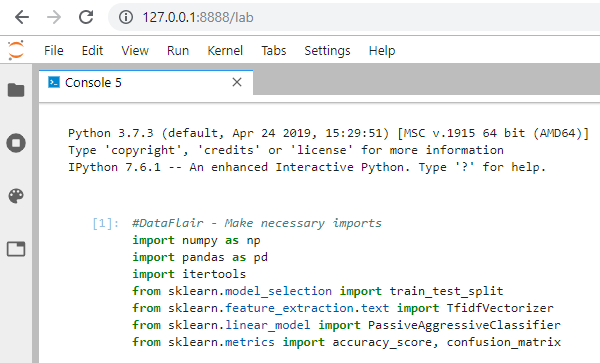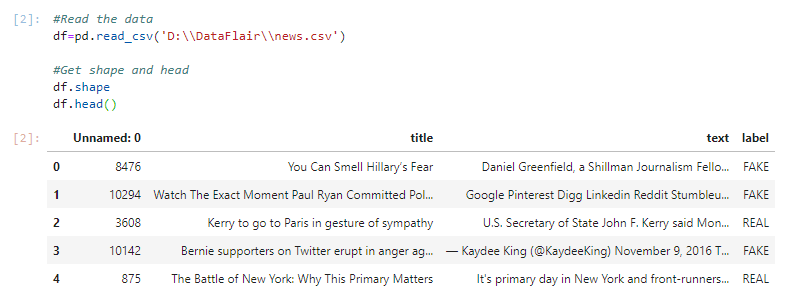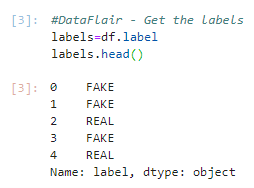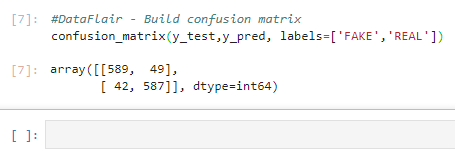Detecting Fake News with Python and Machine Learning
Free Machine Learning courses with 130+ real-time projects Start Now!!
Do you trust all the news you hear from social media?
All news are not real, right?
How will you detect fake news?
The answer is Python. By practicing this advanced python project of detecting fake news, you will easily make a difference between real and fake news.
Before moving ahead in this machine learning project, get aware of the terms related to it like fake news, tfidfvectorizer, PassiveAggressive Classifier.
Also, I like to add that DataFlair has published a series of machine learning Projects where you will get interesting and open-source advanced ml projects. Do check, and then share your experience through comments. Here is the list of top Python projects:
- Fake News Detection Python Project
- Parkinson’s Disease Detection Python Project
- Color Detection Python Project
- Speech Emotion Recognition Python Project
- Breast Cancer Classification Python Project
- Age and Gender Detection Python Project
- Handwritten Digit Recognition Python Project
- Chatbot Python Project
- Driver Drowsiness Detection Python Project
- Traffic Signs Recognition Python Project
- Image Caption Generator Python Project
What is Fake News?
A type of yellow journalism, fake news encapsulates pieces of news that may be hoaxes and is generally spread through social media and other online media. This is often done to further or impose certain ideas and is often achieved with political agendas. Such news items may contain false and/or exaggerated claims, and may end up being viralized by algorithms, and users may end up in a filter bubble.
What is a TfidfVectorizer?
TF (Term Frequency): The number of times a word appears in a document is its Term Frequency. A higher value means a term appears more often than others, and so, the document is a good match when the term is part of the search terms.
IDF (Inverse Document Frequency): Words that occur many times a document, but also occur many times in many others, may be irrelevant. IDF is a measure of how significant a term is in the entire corpus.
The TfidfVectorizer converts a collection of raw documents into a matrix of TF-IDF features.
What is a PassiveAggressiveClassifier?
Passive Aggressive algorithms are online learning algorithms. Such an algorithm remains passive for a correct classification outcome, and turns aggressive in the event of a miscalculation, updating and adjusting. Unlike most other algorithms, it does not converge. Its purpose is to make updates that correct the loss, causing very little change in the norm of the weight vector.
Detecting Fake News with Python
To build a model to accurately classify a piece of news as REAL or FAKE.
About Detecting Fake News with Python
This advanced python project of detecting fake news deals with fake and real news. Using sklearn, we build a TfidfVectorizer on our dataset. Then, we initialize a PassiveAggressive Classifier and fit the model. In the end, the accuracy score and the confusion matrix tell us how well our model fares.
The fake news Dataset
The dataset we’ll use for this python project- we’ll call it news.csv. This dataset has a shape of 7796×4. The first column identifies the news, the second and third are the title and text, and the fourth column has labels denoting whether the news is REAL or FAKE. The dataset takes up 29.2MB of space and you can download it here.
Project Prerequisites
You’ll need to install the following libraries with pip:
pip install numpy pandas sklearn
You’ll need to install Jupyter Lab to run your code. Get to your command prompt and run the following command:
C:\Users\DataFlair>jupyter lab
You’ll see a new browser window open up; create a new console and use it to run your code. To run multiple lines of code at once, press Shift+Enter.
Steps for detecting fake news with Python
Follow the below steps for detecting fake news and complete your first advanced Python Project –
- Make necessary imports:
import numpy as np import pandas as pd import itertools from sklearn.model_selection import train_test_split from sklearn.feature_extraction.text import TfidfVectorizer from sklearn.linear_model import PassiveAggressiveClassifier from sklearn.metrics import accuracy_score, confusion_matrix
Screenshot:
2. Now, let’s read the data into a DataFrame, and get the shape of the data and the first 5 records.
#Read the data
df=pd.read_csv('D:\\DataFlair\\news.csv')
#Get shape and head
df.shape
df.head()Output Screenshot:
3. And get the labels from the DataFrame.
#DataFlair - Get the labels labels=df.label labels.head()
Output Screenshot:
4. Split the dataset into training and testing sets.
#DataFlair - Split the dataset x_train,x_test,y_train,y_test=train_test_split(df['text'], labels, test_size=0.2, random_state=7)
Screenshot:
5. Let’s initialize a TfidfVectorizer with stop words from the English language and a maximum document frequency of 0.7 (terms with a higher document frequency will be discarded). Stop words are the most common words in a language that are to be filtered out before processing the natural language data. And a TfidfVectorizer turns a collection of raw documents into a matrix of TF-IDF features.
Now, fit and transform the vectorizer on the train set, and transform the vectorizer on the test set.
#DataFlair - Initialize a TfidfVectorizer tfidf_vectorizer=TfidfVectorizer(stop_words='english', max_df=0.7) #DataFlair - Fit and transform train set, transform test set tfidf_train=tfidf_vectorizer.fit_transform(x_train) tfidf_test=tfidf_vectorizer.transform(x_test)
Screenshot:
6. Next, we’ll initialize a PassiveAggressiveClassifier. This is. We’ll fit this on tfidf_train and y_train.
Then, we’ll predict on the test set from the TfidfVectorizer and calculate the accuracy with accuracy_score() from sklearn.metrics.
#DataFlair - Initialize a PassiveAggressiveClassifier
pac=PassiveAggressiveClassifier(max_iter=50)
pac.fit(tfidf_train,y_train)
#DataFlair - Predict on the test set and calculate accuracy
y_pred=pac.predict(tfidf_test)
score=accuracy_score(y_test,y_pred)
print(f'Accuracy: {round(score*100,2)}%')Output Screenshot:
7. We got an accuracy of 92.82% with this model. Finally, let’s print out a confusion matrix to gain insight into the number of false and true negatives and positives.
#DataFlair - Build confusion matrix confusion_matrix(y_test,y_pred, labels=['FAKE','REAL'])
Output Screenshot:
So with this model, we have 589 true positives, 587 true negatives, 42 false positives, and 49 false negatives.
Summary
Today, we learned to detect fake news with Python. We took a political dataset, implemented a TfidfVectorizer, initialized a PassiveAggressiveClassifier, and fit our model. We ended up obtaining an accuracy of 92.82% in magnitude.
Hope you enjoyed the fake news detection python project. Keep visiting DataFlair for more interesting python, data science, and machine learning projects.
Did you know we work 24x7 to provide you best tutorials
Please encourage us - write a review on Google









in splitting of data set i am getting error as
value error : found input variable with inconsistent number of samples: [6335 , 5]
did u resolve this eeror?
yess i have made some changes in my program ….. i have learnt several things and finally got it
could to tell me how..i have an idea about what might have caused the error.the post vectorized x_train returns a shape of(2*2) while as the shape is different for y_train…so passive regression wont fit
Can u share the project plz
hey, could someone tell what is the purpose of first column in the data set? what does it represent?
The first column identifies the news.
getting unicode error while running the code in jupyter notebook.please tell me how to resolve.
The unicode issue happens because \u is the default escape code for unicode and can be fixed either by using double slashes ( and no \u anymore) or you can convert to raw string
I recommend you to change the slashes to double backslash (\\) in “df”.
its because in ‘.csv’ file each column is separated by a comma(i.e. delimiter is comma) but a news/article may also contain commas. to remove this error you should use a ‘.tsv’ file (i.e. delimiter is tab).
File “”, line 2
df=pd.read_csv(‘C:\Users\administratt\Downloads\news.csv’)
^
SyntaxError: (unicode error) ‘unicodeescape’ codec can’t decode bytes in position 2-3: truncated \UXXXXXXXX escape
im getting this error ,pls tell me what is solution for this.
change all the \ to / and you are good to go
You can use this df=pd.read_csv(r”C:\Users\Habesha Computers\Documents\posts.csv”) code
The issue happens because \u is the default escape code for Unicode, it can be fixed either by using double slashes (and no \u anymore) or you can convert to raw string
I recommend you to change the slashes to double backslash (\\) in “df”.
write it as
r’C:\Users\administratt\Downloads\news.csv’
and you’re good to go.
i got invalid syntax error in this way
bro, i’m not able to create any GUI. However, I’m getting test result in visual studio. can somebody pls help on this………..
Please post the error message and complete stacktrace, we will look into the issue.
Where is the data sourced from and how is it identified as real or fake?
how can we give new data ..which is a current news and show its output like is fake or it real..how can we give new news article and say that it is fake or not!!
maybe this code can help you
input_data = [input()]
vectorized_input_data = tfidf_vectorizer.transform(input_data)
prediction = pac.predict(vectorized_input_data)
print(prediction)
every news is showing fake
You can pickle or save the model and after preprocessing the new data you can predict the fake or real out of new processed data.
I got an invalid syntax error in this way.
Please let us know on which line you are getting the error.
Also, post the error message and complete stacktrace, we will look into the same.
how can i save the model and use it to predict new articles
You can save the model with .save method and use it. In another project we have shown how to save the model and use it, please refer:
https://data-flair.training/blogs/deep-surveillance-with-deep-learning-intelligent-video-surveillance-project/
I tried this project. Really enjoyed doing it. Thank You for the clear explaination
The fifth step is giving me a value error also saying that np.nan is an invalid document for the fake news prediction.please help me out with this..
I too getting this error can anyone solve it?
You need to convert the dtype object to unicode by .values.astype(‘U’)
Thank you for sharing.
Could you plz explain me i was getting error at this syntax line Fit and transform train set
and how to fix it
Please post the error message and complete stacktrace, we will look into the issue.
getting error while executing pac.fit and pac.predict command
Please post the error message and complete stacktrace, we will look into the issue.
could you please explain the working of this project
After train test split, we preprocess the news with Tfidfvectorizer that computes the word counts, IDF values, and Tf-idf scores all at once.
After fitting and transforming the input we pass it to our algorithm. As our model is trained we fit our model and predict test set to get the accuracy score of our model.
How can we increase the data set , like I have other csv with 1,20,000 values of the same format except the id or key …. the programme doesn’t work with other csv file of same format except instead of unique id it has 0,1,2,3 …
Can you please send a source code so that it can be trained with other data sets too
bro can you share data to me on google drive
Hii Rahul Shrivastav ,
The dataset they are using contains several fields like label, text and title .. you make sure that your dataset contains those fields and you are good to go.
No it’s correct I tried it and it worked for me
I cant execute the following code “C:\Users\DataFlair>jupyter lab” I keep getting the following error “‘jupyter’ is not recognized as an internal or external command,
operable program or batch file.” whats the problem and whats the solution?
It is because of “Environment Variables”
Please follow these steps:
Open the folder where you downloaded “python-3.8.2-amd64.exe” setup or any other version of python package
Double click on “python-3.8.2-amd64.exe’
Click “Modify”
You will see “Optional features”
Click “next”
Select “Add python to environment variables”
Click “install”
Then u can run jupyter from any desired folder
E.g open “cmd” command prompt
Type :
E:
E:>jupyter notebook
It will get started without showing ‘Jupyter’ is not recognized
I’m having a value error in 5 code Can anyone help me to solve this error?
Please post the error message and complete stacktrace, we will look into the issue.
Can anyone one please tell me about the preprocessing part. And how can i give an article to this system and get the output whether it is fake or real . Please help me…..
Here we preprocess the news with Tfidfvectorizer that computes the word counts, IDF values, and Tf-idf scores all at once.
You can pickle or save the model and after preprocessing the new data you can predict the fake or real from newly processed data.
Can we use pycharm instead of jupyter ?
Yes, you can.
Does anybody here knows how to download jupyter lab? And, how to access it from command prompt? I tried but it says it cannot find the file. Can someone help me?
download anaconda
could you please give me the code to plot the confusion matrix??
def plot_confusion_matrix(y_true, y_pred, classes, normalize=False,
title=None, cmap=plt.cm.Blues):
if not title:
if normalize:
title = ‘Normalized confusion matrix’
else:
title = ‘Confusion matrix, without normalization’
cm = confusion_matrix(y_true, y_pred)
classes = classes[unique_labels(y_true, y_pred)]
if normalize: cm = 100 * cm.astype(‘float’) / cm.sum(axis=1)[:, np.newaxis]
fig, ax = plt.subplots()
im = ax.imshow(cm, interpolation=’nearest’, cmap=cmap)
ax.figure.colorbar(im, ax=ax)
ax.set(xticks = np.arange(cm.shape[1]),
yticks = np.arange(cm.shape[0]),
xticklabels = classes, yticklabels=classes,
title = title,
ylabel = ‘True label’,
xlabel = ‘Predicted label’)
plt.setp(ax.get_xticklabels(), rotation=45, ha=’right’,
rotation_mode=’anchor’)
fmt = ‘.1f’ if normalize else ‘d’
thresh = cm.max() / 2
for i in range(cm.shape[0]):
for j in range(cm.shape[1]):
ax.text(j, i, format(cm[i,j], fmt),
ha=’center’, va=’center’,
color=’white’ if cm[i,j] > thresh else ‘black’)
fig.tight_layout()
return ax
I preprocessed the datadue to some criteria before vectorization (splitted unified words with ‘ – ‘ e.g. counter-terrorist , removed words that are non alphabetical and words with length <4,used PorterStemmer) used Stratified K Fold cross validation with 3 to 5 splits on the dataset and i got an average accuracy of approximately 97%
But i worked on jupyter notebook not on lab
Turns out my accuracy is at 92.5 . Before , I falsely vectorized all the dataset before the split
If we train the data with the given dataset and test run it over the completely new data. Will the accuracy be the same?
Accuracy will be similar, but it depends on many factors, I recommend you try running the project.
What types of Algorithms are used in this project
In this machine learning project we are using PassiveAggressiveClassifier the Passive-Aggressive algorithms are generally used for large-scale learning. This algo is one of the few ‘online-learning algorithms‘. In online ml algorithms, the input data comes in sequential order and then model is updated step-by-step, as opposed to batch machine learning, where the entire training dataset is used in one shot. This is very useful in situations where there is a huge amount of data and new data is being added every continuously.
I got ValueError in Step 6 while trying to run y_pred=pac.predict(tfidf_test). Can someone help to explain why do i received error at this step?
Please check for the array size of the tfidf_test.